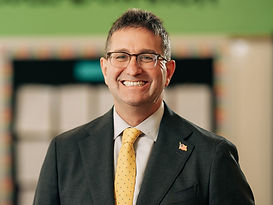GUEST COLUMN.
DECLINING TRUST UNDERMINES DEMOCRACY
By David Swindell, Director and Professor, Center for Urban Innovation, School of Public Affairs, Arizona State University

America has experienced a decades-long slide in trust. According to the Pew Research Center, the percent of Americans that believe they trust the national government to do what is right has fallen from its high of 77% in 1964 and reached 22% in 2024.
Historically, Americans have trusted their local governments more than other public institutions. Now, however, even local government trust is declining, dropping over eight percentage points since COVID-19. In 2023, work by Government Leadership Solutions and Envisio showed that local government leaders are fully aware of the threat and reported that this decline in trust was the biggest threat to their communities, exceeding traditional issues like infrastructure and budget pressures.
Trust is essential for a number of reasons. It helps create an environment in which people looking to associate with one another or with their government can more easily work together towards solutions to public problems. It supports a vibrant economy by building confidence among citizens that others will abide by contracts due to the government’s role of providing a stable legal playing field. Research has found that higher trust is associated with better-functioning and more democratic institutions.
Trust is a prerequisite for a healthy democratic society. If government institutions (at all levels of government) fail to serve the needs of residents, fail to demonstrate accountability, or just fail to inform the public of public actions as a practice of transparency, then people are more likely to feel less trust towards those institutions. And this leads to an array of pathologies in society.
Less trusting Americans are more likely to question the legitimacy of institutions and the leaders of those institutions, like mayors and city councilors. This can and does lead to disengagement from the electoral system, meaning the more politically polarized are left to have an increased influence at the ballot box. The leaders they elect are likely to be opposed to compromise, exacerbating the inability of local government to solve basic problems and service delivery needs.
What’s more, people whose faith in government is flagging tend to withdraw from other civic duties as well, weakening the civic fabric further. They are more likely to be drawn to more extremist movements. Such individuals may take advantage of social media outlets to exploit public anger, further eroding social norms.
This increases the likelihood that these individuals (or those sympathetic to them) may ignore or resist government directives through actions such as tax evasion or vaccine hesitancy. As a result, public servants may become demoralized as those they serve increasingly demonize them, which will make recruitment and retention of individuals committed to a public service ethic more difficult. As less committed individuals take those jobs, service quality may suffer and fuel the frustrations with government.
There are numerous techniques and actions that government institutions can undertake that can counter the decline in trust in their communities. Many of these are simply tied to improvements in service delivery and quality. For instance, technologies are easing the barriers to entry to move local government service providers to greater digital access. These processes can expedite items like service requests, various permits, or payments. Lowering the barriers to service access by removing red tape makes the organization more responsive to citizen- and other stakeholder needs.
Perhaps one of the best ways to convince residents that their local governments are trustworthy is by delivering quality services. While this sounds simple and perhaps obvious, achieving this goal requires several commensurate actions. First, the unit must commit to this goal and hold itself accountable. Second, to do that, the unit must also measure performance, so it knows the level of quality it is producing and adjust as needed. And third, it must share that performance information publicly.
Sharing performance information through clear and proactive communication channels is also part of increasing the kind of transparency that leads to trust in local government. Providing open data portals is not only useful for performance metrics and dashboards, but also for budget information and solicitation of citizens to participate in public decisions through meaningful public forums. Public engagement through town halls or participatory budgeting exercises helps provide an avenue for citizens to meaningfully participate and see their local government and fellow citizens in action. Through that engagement, individuals gain first-hand knowledge that can counter inaccurate information gleaned from social media.
Another dimension to the clear communication strategy is to help citizens understand that local government is accountable. Declines in performance metrics or a service delivery failure must be communicated and responsibility accepted. But again, that is only part of the process. The second part is indicating what steps are being taken to address the situation. And the final step is closing the loop by reporting back to the public on the progress on the outcomes.
There is no secret or silver bullet solution to combat declining trust. These action steps may sound easy, but most communities fail not due to lack of interest or even lack of effort. More often, they fail on implementation and follow through. If a community solves some problem or captures an increase in service satisfaction and never tells the public, how can that impact residents’ confidence in the local government’s commitment to transparency, accountability, and engagement?
The contents of this Guest Column are those of the author, and not necessarily Barrett and Greene, Inc.
#StateandLocalTrustInGovernment #StateandLocalGovernmentTransparency #StateandLocalGovernmentPerformance #StateandLocalPeformanceMeasurement #StateandLocalPerformanceManagement #StateandLocalGovernmentManagement #StateandLocalServiceQuality #CityPerformanceManagement #CityPerformanceMeasurement #StateandLocalGovernmentHumanResources #StateandLocalGovernmentWorkforce #CityGovernmentTransparency #StateandLocalGovernmentAccountability #CityGovernmentAccountability #CountyGovernmentPerformanceMeasurement #CountyGovernmentTransparency #TrustInCityGovernment #TrustInCountyGovernment #TrustInStateGovernment #GovernmentLeadershipSolutions #Envisio #PewCharitableTrusts #DecliningGovernmentTrust #StateandLocalCitizenEngagement #StateandLocalPerformanceReporting #StateandLocalGovernmentDataPortals #StateandLocalDataTransparency #ThreatToDemocracy #DavidSwindell #SchoolOfPublicAffairsArizonaState #ArizonaStateUniversity #SolutionsToDecliningGovernmentTrust #CombattingDecliningGovernmentTrust #BandGGuestColumn #BarrettandGreeneInc



































































































